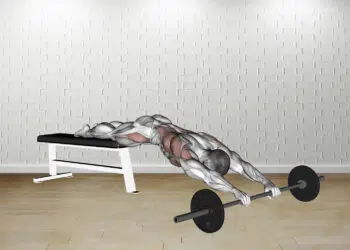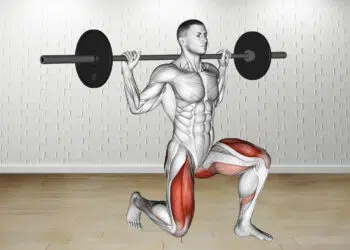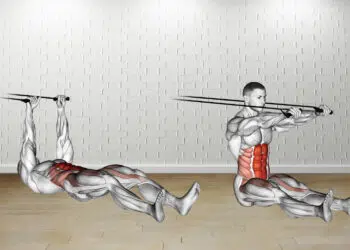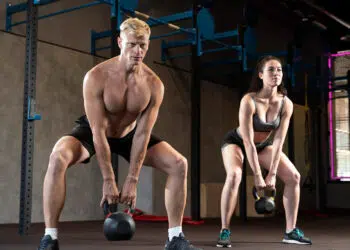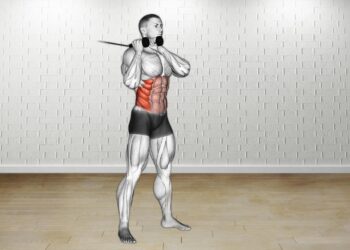Cocoons might sound like a complex exercise but you can rest assured it’s as simple as can be. Easy? Well, that depends on your level of fitness and experience. But for most people in decent shape, they’re totally doable. The exercise, as the name suggests, mimics the protective covering that is formed by insects as they transition.
And it’s a fantastic exercise for engaging all of the core muscles while also involving the movement of the hips. But primarily, it’s going to help you develop those six-pack abs and improve core strength that’ll help you to perform better all-around.
In this article, we’ve explained how to do it, plus tips, variations, and advice for how to effectively include it in your training regime.
Here’s a guide to cocoons…
Muscles Worked
Cocoons revolve around the core and hip muscles. Learn how they function and where they are anatomically.
Iliopsoas
The iliopsoas is a clan of muscles including psoas major, psoas minor, and iliacus. It’s the primary flexor of the hip joint (e.g., pulling the legs in toward the chest during cocoons) and stabilizes the pelvis and lumbar spine individually. Anatomically, the iliopsoas starts from the vertebral column and hip and inserting on the femur.
Level Up Your Fitness: Join our 💪 strong community in Fitness Volt Newsletter. Get daily inspiration, expert-backed workouts, nutrition tips, the latest in strength sports, and the support you need to reach your goals. Subscribe for free!
Rectus Abdominis
Rectus abdominis is the external abdominal core muscles that often appear like two rows of individual square shaped muscles commonly referred to as a “six pack”. These muscles allow top and bottom of the torso to curl up toward the center of the body. They also help us to bend toward either side (flexion).
Cocoons are a good core strengthening exercise, however, it’s also good to improve your core development.
Related: The Best Six-Pack Abs Workout You Can Do At Home
How To Do Cocoons
Cocoons are rather straightforward and nothing too much different than what you probably already do for abs training. But here are step-by-step instructions to ensure you do them safely and effectively.
- Lie on your back with legs extended and arms extended behind your head.
- Pull your knees in toward your chest and lift your butt up while simultaneously bringing your arms all the way toward and over your knees to perform a crunch.
- Return to the starting position but this time, keep your legs off the ground high enough to where your lower back is still mostly in contact with the ground.
- Repeat for the desired number of reps.
Here’s a video example…
Cocoons exercise tips
- Your arms and legs should move in and out at the exact same time to effectively engage the core muscles equally.
- Don’t swing your legs and arms toward each other; focus on engaging the core muscles.
- Avoid lowering your heels to the floor to keep tension on your core muscles, but keep your feet high enough to where your lower back is in contact with the ground. This is recommended to avoid stressing the lower back.
3 Variations
Cocoons are a pretty effective exercise for training the core muscles. But they’re definitely not the only variation that involves simultaneous movement of the lower and upper body. Here are three variations that we think you should also try.
Weighted cocoons
You can do this exercise while holding a fixed barbell behind your head instead of just bodyweight only. But instead of bringing your arms forward over your legs, touch the bar to your hip crease as you bring the knees toward the chest.
Level Up Your Fitness: Join our 💪 strong community in Fitness Volt Newsletter. Get daily inspiration, expert-backed workouts, nutrition tips, the latest in strength sports, and the support you need to reach your goals. Subscribe for free!
Straight leg V-ups
V-ups are very similar to cocoons except the legs are kept straight rather than bent. So as you lift the legs up, you’ll also reach up to touch the toes.
Seated knee tuck
The seated knee tuck exercise is also another great variation for working the entire core by incorporating the legs and upper body. To do it, sit up and place your arms by your sides then extend your legs while simultaneously leaning back as far as you can. You’ll then bring the knees and upper body together at the same time. keep tension on the core and don’t let your legs touch the ground.
Read: Get ‘6 Pack’ Abs In 22 Days With This Home Workout
How To Incorporate Cocoons Into Your Training Routine
Cocoons are a core exercise and therefore should be trained along with your other core movements.
But as far as the order in which you perform this exercise, we recommend doing your hanging leg raise or leg lift variations first because they are typically the most challenging. Then, you’d follow this up with an exercise that involves the lower and upper body such as the cocoon. After this, you can do a top-down exercise such as the basic crunch, then add a lying rotational exercise for obliques before standing up and doing a cable twist variation such as wood chops for the obliques.
Training this way allows you to maximize your efforts by doing the most challenging exercise first when you’re fresh and have the most energy.
Sets/reps
We recommend doing at least 3 sets of cocoons to failure to maximize the engagement of the core muscles. You’ll know you’re done with your sets when you can no longer perform a rep using a full range of motion.
As for training frequency, once or twice per week as part of your core training workouts is plenty.
Wrapping Up
Cocoons are an exercise that you probably never heard of until now. That doesn’t mean they aren’t effective or useful though. You can rest assured that if you include these in your core routine, you’ll feel a burn like no other and you’ll begin to see the benefits if you’re consistent.
It’s a simple exercise but that doesn’t mean it’s easy, however, the more you challenge yourself, the better the results will be, as you’re probably aware. We hope this exercise guide was helpful for you in your ab training pursuits.
Interested in measuring your progress? Check out our strength standards for Hanging Leg Raise.


